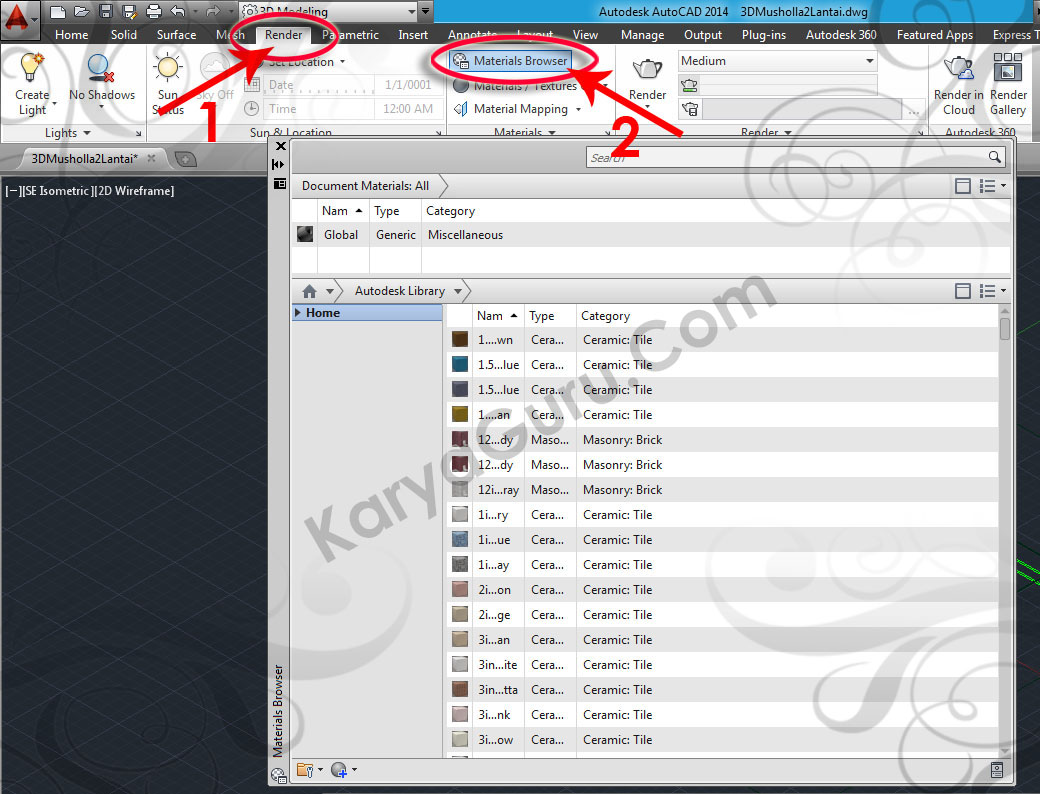In this exercise, you will use some of the visualization features in AutoCAD Civil 3D to render a surface.
Like other AutoCAD Civil 3D objects, you must apply a render material to the surface using the Surface Properties dialog box.
AutoCAD 2016 For Architectural Design: Floor Plans, Elevations, Printing, 3D Architectural Modeling, and Rendering - Kindle edition by Tutorial Books. Download it once and read it on your Kindle device, PC, phones or tablets. This tutorial demonstrates how to add multi-view blocks to a surface and render it using a sample of the visualization techniques included with AutoCAD Civil 3D. AutoCAD Civil 3D uses the same rendering functionality as standard AutoCAD. At a basic level, you can use the Render command to render your model without applying any materials, adding any lights, or setting up a scene.
This exercise continues from Exercise 1: Moving Blocks to a Surface.
Apply a render material to the surface
- In Toolspace, on the Prospector tab, expand the Surfaces collection.
- Right-click the XGND surface. Click Surface Properties.
- In the Surface Properties dialog box, on the Information tab, specify the following parameters:
- Render Material: Sitework.Planting.Sand
This render material displays contrast in the surface elevations.
- Surface Style: Standard
- Render Material: Sitework.Planting.Sand
- Click OK.
This exercise uses Surface-7.dwg with the modifications you made in the previous exercise.

Apply a visual style to the surface
- Click View tab Visual Styles panel Visual Styles drop-down Realistic.
This visual style shades the surface and smooths the edges between polygon faces. The render material that you applied to the surface is displayed.
- Click View tab Visual Styles panel Visual Styles drop-down Conceptual.
This visual style shades the surface and smooths the edges between polygon faces. The shading in this style uses the Gooch face style, a transition between cool and warm colors rather than dark to light. The effect is less realistic, but it can make the details of the model easier to see.
Visual Styles give a fast, basic visualization of the surface that is useful for on-screen presentation in AutoCAD Civil 3D.
Render the surface
- On the command line, enter RPREF.
Examine the many render settings that are available, including variations in image quality and output size. If you wanted to save the rendered image to a file, you would click and use the Output File Name control to specify a file name and destination.
- Click .
The surface and blocks are rendered in the Render window. The effects of rendering are more apparent in a drawing that has different render materials applied to several surfaces and objects.

Released
 3/18/2015 Add 3D life to 2D drawings; learn to render your designs with AutoCAD. Join Eric Wing in this course, as he teaches designers how to create materials, apply them to objects, and render out scenes in AutoCAD. He also shows how to set the viewing environment with visual styles and views, add cool lighting, and create motion-path animations. Using these techniques, you can ensure your architectural renderings will never be boring, flat, or static. Topics include:
3/18/2015 Add 3D life to 2D drawings; learn to render your designs with AutoCAD. Join Eric Wing in this course, as he teaches designers how to create materials, apply them to objects, and render out scenes in AutoCAD. He also shows how to set the viewing environment with visual styles and views, add cool lighting, and create motion-path animations. Using these techniques, you can ensure your architectural renderings will never be boring, flat, or static. Topics include: - Exploring workspaces
- Adding and mapping materials
- Setting up visual styles and viewports
- Adding and adjusting lighting
- Rendering a scene
- Creating cameras
- Animating a scene
Autocad 3d Rendering Tutorial For Beginners
Duration
Autocad 2010 3d Rendering Tutorial
- [Voiceover] Hi, I'm Eric Wing, and welcome to Renderingwith AutoCAD.In this course, we'll look at how to create materials,apply them to objects, and render the scene.I'll start by showing you how to set up your workspace.Then, I'll show you how to find and create materials.We'll learn how to configure visual styles, cool lighting,as well as motion path animation.We'll be covering all of these features, plus plenty ofother tools and techniques.Now, let's get started with Rendering with AutoCAD.